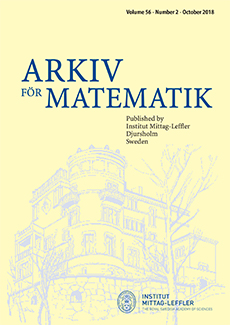Abstract
For Ξ∈Rn, t∈R and f∈S(Rn) define $\left( {S^2 f} \right)\left( t \right)\left( \xi \right) = \exp \left( {it\left| \xi \right|^2 } \right)\hat f\left( \xi \right)$ . We determine the optimal regularity s0 such that $\int_{R^n } {\left\| {(S^2 f)[x]} \right\|_{L^2 (R)}^2 \frac{{dx}}{{(1 + |x|)^b }} \leqslant C\left\| f \right\|_{H^s (R^n )}^2 ,s > s_0 } ,$ holds where C is independent of f∈S(Rn) or we show that such optimal regularity does not exist. This problem has been treated earlier, e.g. by Ben-Artzi and Klainerman [2], Kato and Yajima [4], Simon [6], Vega [9] and Wang [11].
Our theorems can be generalized to the case where the exp(it|ξ|2) is replaced by exp(it|ξ|a), a≠2.
The proof uses Parseval's formula on R, orthogonality arguments arising from decomposing L2(Rn) using spherical harmonics and a uniform estimate for Bessel functions. Homogeneity arguments are used to show that results are sharp with respect to regularity.
Note
Part of this research was carried out in July 1994 when I enjoyed a stay at Johannes Kepler Universität, Linz. I would like to thank Jim Cooper, Eva Matoušková, Paul Müller, Charles Stegall, Michael Schmuckenschläger and Renata Mühlbachler for having created a stimulating and friendly atmosphere in the functional analysis group at Linz. I would also like to thank Professor Per Sjölin for valuable comments and for encouraging me to carry out the investigation presented here, Professor Krzysztof Stempak, Uniwersytet Wrocławski, Wrocław for help regarding improvements of the presentation and the referee for comments and criticism.
Citation
Björn G. Walther. "A sharp weighted L2-estimate for the solution to the time-dependent Schrödinger equation." Ark. Mat. 37 (2) 381 - 393, October 1999. https://doi.org/10.1007/BF02412222
Information





